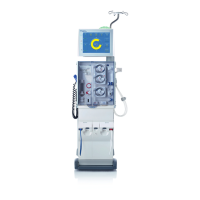
Do you have a question about the Fresenius Medical Care 5008 and is the answer not in the manual?
| Brand | Fresenius Medical Care |
|---|---|
| Model | 5008 |
| Category | Medical Equipment |
| Language | English |
Guidance on how to use the manual and interpret its content.
Overview of the hemodialysis system's capabilities, safety features, and technical specifications.
Contact information for the manufacturer and service centers.
Identifies key components visible from the front of the hemodialysis system.
Identifies key components visible from the rear of the hemodialysis system.
Details the main components of the extracorporeal blood circuit, including pumps and detectors.
Identifies the main parts of the hydraulic system, such as flaps and suction tubes.
Describes the initial startup screens and selections after powering on the system.
Details the main elements and indicators on the system's display screen.
Explains the basic principles of controlling the system via the screen menu.
Step-by-step guide for preparing the system using ONLINEplus™ and rinse solution bags.
Detailed steps for performing treatment using ONLINEplus™ and rinse solution bags.
Procedures for reinfusion using ONLINEplus™ and rinse solution bags.
Basic requirements, connection, starting, aborting, and completing cleaning programs.
Explanation of different message categories (Info, Warning, Alarm) and retrieval methods.
Procedure for responding to air detection alarms and performing air removal.
Procedure for handling micro bubble alarms and their removal.
Information on blood leak detection, causes, and override procedures.
How to select and adjust system screen settings like date, time, and brightness.
Guide for configuring operator-specific settings for blood lines, pump, and delivery rates.
Details on setting and activating/deactivating the emergency button functions.
Criteria and procedure for changing the DIASAFE®plus filter.
Details system dimensions, weight, electrical safety, and supply requirements.
Information on electromagnetic emissions and immunity according to IEC standards.
Specifies environmental conditions and operating parameters for the system.
Details dialysate circuit components and safety systems like blood leak detector and TMP.
Diagrams and descriptions of the extracorporeal blood circuit and its parts.
Diagrams and labeling of blood lines for various configurations.
Instructions to follow before and during the initial start-up of the system.
Information regarding mandatory Technical Safety Checks and Measurement Checks.
Definitions of technical terms used throughout the operating instructions.
Alphabetical list of abbreviations with their full meanings.
Explanation of symbols used on the system and consumables packaging.
Introduction to the chapter covering system consumables and their usage.
Lists available dialyzer models and blood lines for the system.
Details dialysate filters, disposable syringes, and hemodialysis concentrates.
Displays the EC certificate issued by TUV SUD for the system.
Lists references related to dialysis and system components.
Important considerations before OCM use, and definitions of key terms like Kt/V.
Details OCM screen elements and guide for setting parameters like Kt/V and Interval.
Procedure for initiating, aborting, and handling stability criteria for OCM.
Details ONLINEplus™ screen elements and guides for preparation, treatment, and reinfusion.
Details the SN option's menu structure and procedures for preparation, treatment, and reinfusion.
Important precautions before BPM use, including cuff and tubing compatibility.
Details BPM screen elements and guides for starting, aborting, and viewing measurements.
Instructions for applying the cuff and checking/setting inflation pressure and alarm limits.
Important notes regarding ambient temperature and blood line placement for BTM accuracy.
Details BTM screen elements for recirculation, temperature control, and graphics.
Procedures for starting, aborting, and managing recirculation and temperature control.
Important notes regarding BVM operation with special blood lines and cuvettes.
Details BVM screen elements and guide for setting UF goal, RBV, and Hemoglobin.
Requirements for BVM calibration and procedure for measuring RBV, Hb, and Hct.
Describes BVM-related alarms like UF goal uncertainty and low blood flow, and how to respond.
Precautions for data transfer via network, including parameter checks and data protection.
Information about the DataXchange Panel for data processing and transfer, including operation philosophy.
Definitions of BLK (kinking/clotting) and WET (hydrophobic filter) options and their purpose.
Task and description of the BLK option for detecting kinking and clotting in blood lines.
Task, description, and alarm processing for the WET option, detecting a wet hydrophobic filter.
Notes on smartbag usage, concentrate supply, and step-by-step connection instructions.

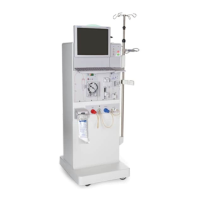
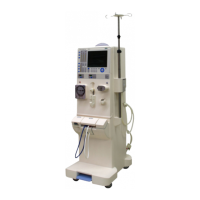
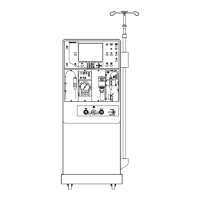
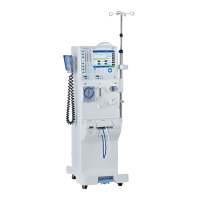


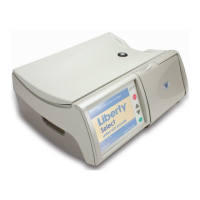
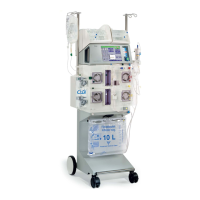



